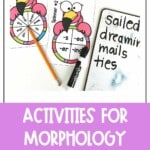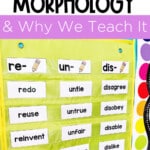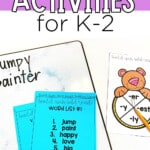

One morning, I had a conversation with my four year old that reminded me about why morphology is important. It went a little something like this…
Daughter: “Mom, Mrs. Miller is the kinder teacher I’ve ever met.”
Me: After thinking for a minute. “Are you saying Mrs. Miller is the most kind teacher you have had at school?”
Daughter: “Yes!”
Me: “When you want to say someone is the most kind or the most tall, etc. you add -est to the end of the word. You would say kindest or tallest. So Mrs. Miller is the kindest teacher you’ve ever met.”
Daughter: “Okay, mommy!”
This is a funny story that my friend shared as we talked about morphology, but it happens all the time with young kids. They don’t know how to correctly add endings to words, or they aren’t sure how to correctly structure their sentence. What is morphology and how can we support students with this skill in the classroom?
Morphology is simply the study of words. Morphemes are the smallest units of meaning in a word. These units can be base words that stand alone, prefixes, or suffixes. An example base word would be the word ‘play’. We could add the prefix re- to the word ‘play’ and change the meaning. We are now asking that something be played again.
We could also just add the suffix -ed to the word ‘play’ to again change the meaning. Now, we are using past tense. Morphology also includes other grammar features such as adding -s or -es to the end of a word to make it plural.
Morphology is an important skill for students to develop in reading and spelling. We use morphemes to convey meaning when we talk and write. We also encounter them when we read. In order for students to make sense of what they are reading, spelling, or writing, they need to understand the structure of words.
When students have knowledge of prefixes, suffixes, and base words, they can better understand the meaning of unknown words. Knowing the prefix re- means again or back can help a student understand the word ‘redo’. Morphological awareness is fundamental when a student begins to read to learn information or when reading textbooks, as the language is more academic.
Morphology is also important for helping students with their reading comprehension. When a student encounters a difficult word and is able to determine the meaning of the word and keep reading, they are better able to make sense of what they are reading.
Explicit instruction in prefixes, suffixes, word parts and grammar helps students grow their vocabulary and their knowledge of words. One easy way to do this is during your interactive read aloud. Look for words that have prefixes or suffixes and then show the word to your students. Discuss the meaning of the word with the prefix or suffix added and also without it. You could start a chart of words you find in your read alouds.
Another easy way to introduce these concepts to your students is through word sorts. These help students discover different prefixes and suffixes by sorting words.
Are you looking for already made phonics and word work activities for your students? I have a first grade bundle ready for you HERE. With over 60 activities (including morphology activities), you’ll be set for centers, small groups, and 1-1 intervention time.
How do you teach your students about morphology? I’d love to hear your comments below. Happy Teaching!

Want to use the latest research to boost your readers during small groups? This FREE guide is packed with engaging ideas to help them grow!

I’m a K-1 teacher who is passionate about making lessons your students love and that are easy to implement for teachers. Helping teachers like you navigate their way through their literacy block brings me great joy. I am a lifelong learner who loves staying on top of current literacy learning and practices. Here, you’ll find the tools you need to move your K-2 students forward!


| Cookie | Duration | Description |
|---|---|---|
| cookielawinfo-checkbox-analytics | 11 months | This cookie is set by GDPR Cookie Consent plugin. The cookie is used to store the user consent for the cookies in the category "Analytics". |
| cookielawinfo-checkbox-functional | 11 months | The cookie is set by GDPR cookie consent to record the user consent for the cookies in the category "Functional". |
| cookielawinfo-checkbox-necessary | 11 months | This cookie is set by GDPR Cookie Consent plugin. The cookies is used to store the user consent for the cookies in the category "Necessary". |
| cookielawinfo-checkbox-others | 11 months | This cookie is set by GDPR Cookie Consent plugin. The cookie is used to store the user consent for the cookies in the category "Other. |
| cookielawinfo-checkbox-performance | 11 months | This cookie is set by GDPR Cookie Consent plugin. The cookie is used to store the user consent for the cookies in the category "Performance". |
| viewed_cookie_policy | 11 months | The cookie is set by the GDPR Cookie Consent plugin and is used to store whether or not user has consented to the use of cookies. It does not store any personal data. |



One Response
Thank you for your input and fresh ideas to reach my students.